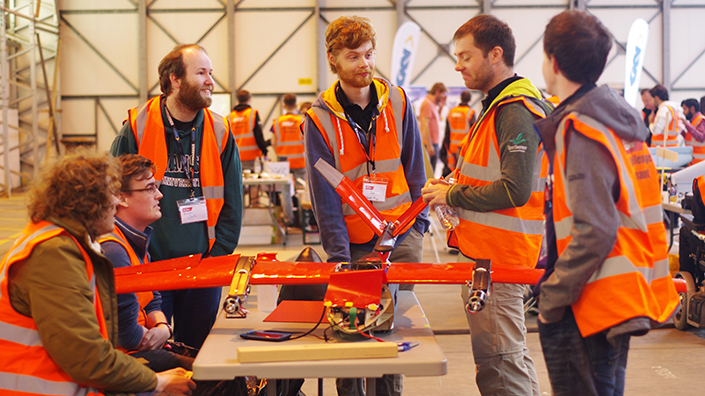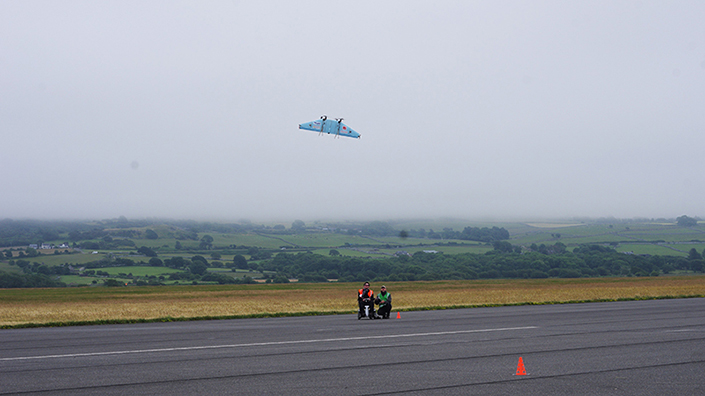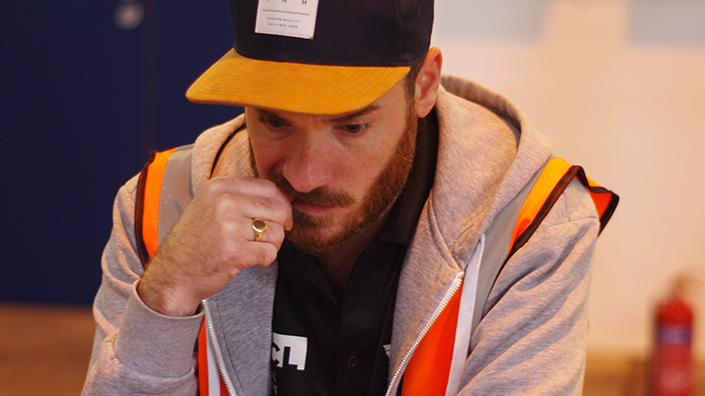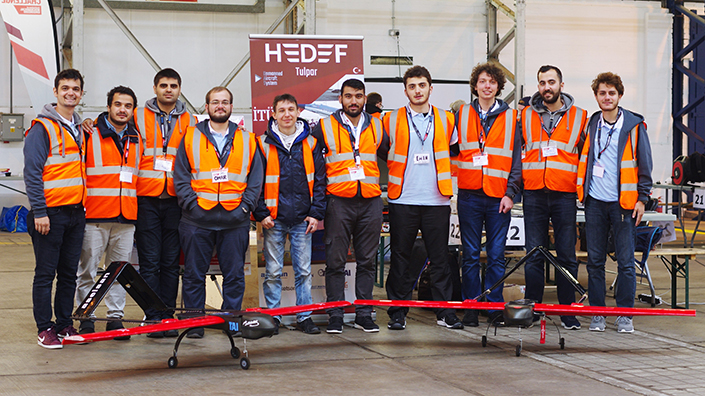Nervous spectators watch with bated breath as it sways alarmingly in the breeze. Will its mission be a success? Can it drop its payload accurately without damaging the precious cargo of emergency aid?
This is not a scene from a war-torn disaster area. In fact, we’re on an airfield just outside the sleepy village of Llanbedr in North Wales. This is the UAS Challenge, a competition to design, build and fly unmanned aircraft systems that is open to universities from around the world, and hosted by the Institution of Mechanical Engineers. The competition, which has been running for four years, aims to bridge the gap between academia and the workplace by giving undergraduates a taste of what aerospace engineering is like on real-world projects. Each year presents a slightly different challenge. This year, it’s to simulate a humanitarian aid drop.
To succeed, the teams have to overcome the problem of building a portable, safe, speedy and efficient aircraft that can carry and drop payloads accurately, and that weighs less than 7kg. Rod Williams, the competition’s chief scrutineer, calls it the “classic designer’s challenge”.
“There are quite significant constraints in terms of weight, and then to be able to deliver a payload or have a camera system that can meet the recognition requirement of the targets,” he says. “So that dual role has obviously got the classic designer’s challenge of the weight penalty against the size and operational capability.”
The challenge is spread across two ‘humanitarian missions’. On day one, the teams have to accurately deliver 500g or 1kg bags of flour, representing aid, to a designated target while navigating a series of waypoints. Day two’s task is to locate and identify four targets within two 200m X 200m squares, reporting back the GPS co-ordinates and alphanumeric character of each target by data link during flight.
The nature of the challenges inspired a high level of innovation, most of which focused on achieving a balance between the accuracy and stability of rotary-style drones and the speed, range and flight efficiency of fixed-wing aircraft. Indeed, this year’s competition saw the first use of hybrid drones, which sought to combine the advantages of rotor and aerofoil in a single airframe.
Here’s how the teams responded – four stories of high-intensity innovation...
Team Cigno: tilt rotor enables dual-wing configuration

Team Cigno used a tilt-rotor design
Swansea University’s Team Cigno came up with an innovative ‘tilt rotor’ design. The drone looks like a standard fixed-wing aircraft except that the propellers on the wings can rotate 90°, providing vertical take-off, before flipping back to provide normal fixed-wing flight.
“We can take-off and face our drone in any direction,” says team leader Dominic Kay. “So it’s quicker than looping round like a fixed-wing aircraft. Then in flight we get a much bigger range using fixed wing, and it allows us to carry a lot more payload.”
What makes Team Cigno’s idea even more innovative is that it evolved from an initial three-rotor design, with two on the main wings and one on the tail, to a two-rotor configuration with just the two wing rotors providing the vertical and forward thrust. The main challenge is the transition between the two forms of flight. “When you’re up there and changing modes, that’s when it’s unstable and a lot of problems can occur,” says Kay.
The verdict: This is innovative, but in practice Team Cigno’s tilt-rotor concept only managed to fly in fixed-wing mode and its powerful motors caused it to crash on landing.
Team Horus: Novel 'tail-sitter' design enables vertical landing

The Team Horus drone takes off and lands vertically
Another inventive take on the hybrid concept came from the University of Southampton’s Team Horus. The team’s ‘tail-sitter’ design means the aircraft does literally that – when not in motion it sits on its tail. This counter-intuitive configuration means that the four propellers attached to the wings – two below and two above – enable it to take-off and land vertically.
When forward flight begins, differential thrust enables the craft to flip over into fixed-wing mode. “You put more power on the top motors,” says the team’s aerodynamics engineer, Mathew Wellman, “and essentially push it over, then the wing just takes over.”
The team’s tail-sitter design was so ingenious that it’s attracted interest from a local autonomous-drones company.
Verdict: This is another impressive hybrid option, although Team Horus only flew in hover mode, unable to find the power to flip the craft over into fixed-wing flight. “What was great was to see those hybrid options,” says chief scrutineer Rod Williams. “They weren’t taking an easy approach. They’d done their design concept analysis, and they went with it.”
Team Nova: Jet-powered drone driven by market need

Team Nova used genetic algorithms to virtually optimise the model
University College London’s Team Nova created a jet-powered drone. The jet engine, which runs at 160,000rpm at full throttle, offsets the weight of the payload, lifting up to 4kg, and supports a standard quadcopter design powered by an alternator also running off the engine. The craft has a tail rotor to counteract torque from the engine. Team leader Syed Ismail Ahmad reckons the design is a world first.
In natural disasters, one of the first things to go down is often the electricity supply, so the team avoided using batteries that would need charging. Team Nova thought small and flexible when it came to fuel. “This jet engine can run on kerosene, diesel and jet A-1,” says Ahmad. “So if you come down on an aircraft, you can siphon jet A-1 from that. You can usually find diesel from cars, and kerosene is usually quite available in developing countries because they use it in their stoves.”
The design process itself was highly innovative. Team Nova used genetic algorithms to optimise the model virtually, without the need for flight testing.
Verdict: Team Nova’s jet engine won an award for most promise, although the drone didn’t manage to get airborne in test flights.
Team Hedef: The winning inverted V-tail design

Team Hedef pose with their traditionally-designed drones
Ironically for a competition that was characterised by innovation, it was a traditional design that won. Istanbul Technical University’s Team Hedef – one of four overseas teams – went for a fixed-wing aircraft with an inverted V-tail design.
The team impressed the judges with their thorough organisation and preparedness for the event. The team had already flown more than 40 flights over 11 full days of testing, often putting in 20-hour weeks on the project on top of their studies.
Team Hedef came to the competition with two fully working aircraft.
Team leader Barış Öndeş says: “We chose this design because we wanted to do both missions with the same aircraft with the same components, so we could conduct the payload delivery mission and also the reconnaissance mission without changing anything on the aircraft.”
The V-tail design gives great stability, meaning the craft can fly in up to 30-knot winds, according to Öndeş, and its aerodynamic efficiency gives it a range of more than 10km. Its lightweight carbon-fibre wings can bear more than 4G loads, which was part of the reason the drone also won the safety and airworthiness award.
Verdict: Team Hedef from Istanbul Technical University were crowned winners for their fixed-wing drone. Their design was simpler than most, but benefited from rigorous testing before the competition, with more than 40 test flights.
Ideas might fly
Industry keeps a close eye on the UAS Challenge, with organisations such as Qinetiq, GKN Aerospace, Frazer-Nash, The Bionic Eye and Bombardier all sponsoring or partnering the event.
“Industry is watching these things absolutely,” says Williams. “Maybe there’s a little bit of innovation that’s enough to seed something that’s viable to take on from there. It might be some little idea they’ve incorporated which makes them go ‘Oh yeah’. Whether it’s to take an individual on or develop the idea, it’s definitely an opportunity for industry."
Content published by Professional Engineering does not necessarily represent the views of the Institution of Mechanical Engineers.